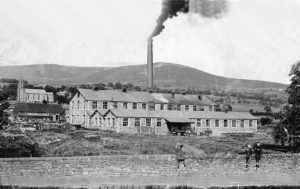On a dry and calm Saturday, with hazy sun, the Pendle Archaeology Group decided to revisit Heyhouses in the ‘Hidden’ or Sabden Valley. The morning was spent exploring the old settlement and talking about its historical and agricultural background from the 14C to the late 18C. This involved examining old photos of cottages, comparing old maps with modern ones and discussing what had disappeared.

Lodge at Heyhouses, connected to the Caolico Print Works. Attribution: C. Rousseau Jones
At the end of the 18C came the Calico Printworks and the impact of the Industrial Revolution on Sabden was immediate. Textile printers poured into the hamlet in increasing numbers from Padiham, Accrington, Rossendale and from as far afield as Preston. The demand for housing led to Top, Step, Bury, Crow Trees, Centre and Long Rows. The first church to be built was the Baptist Church in 1797. Baptism was not by fire, but by a refreshing immersion in the mill lodge on Badger Wells Water.
These printworks consumed vast quantities of clean water and soon Badger Wells Water could not supply all that was required. New lodges were built up the Sabden Brook valley between Sabden and Dean Farm. After lunch, the group played detective. Using a blank 1844 map, they mapped the many lodges and water channels, so as to understand the complexities of one aspect of the calico printing process.

The former Calico Print Works at Sabden. Courtesy of Brian Jeffery
After a final discussion, the group briefly looked at an even older water channel and a potential ‘bloomery’ or early iron smelting site before departing for a well-earned cup of tea. Brian Jeffery 24 March 2019
We also listened to a surprising impromptu rendering of poignant poetry by William Neary and heard the cry of the curlews too.
Banner Image: Culvert at Heyhouses, connected to the Calico Print Works. Attribution: C. Rousseau Jones